Apples are among the most popular fruits in the United States. Bananas claim the top spot as Americans’ favorite fresh fruit. Considering the inclusion of frozen, juice, and canned fruit products, apples surpass all other fruits by a substantial margin in terms of consumption. So, where do all these apples originate? There’s a high probability they come from in one of the states mentioned below. Out of the 36 U.S. states that commercially cultivate apple trees, these ten states consistently lead in annual apple production.
1. Washington State
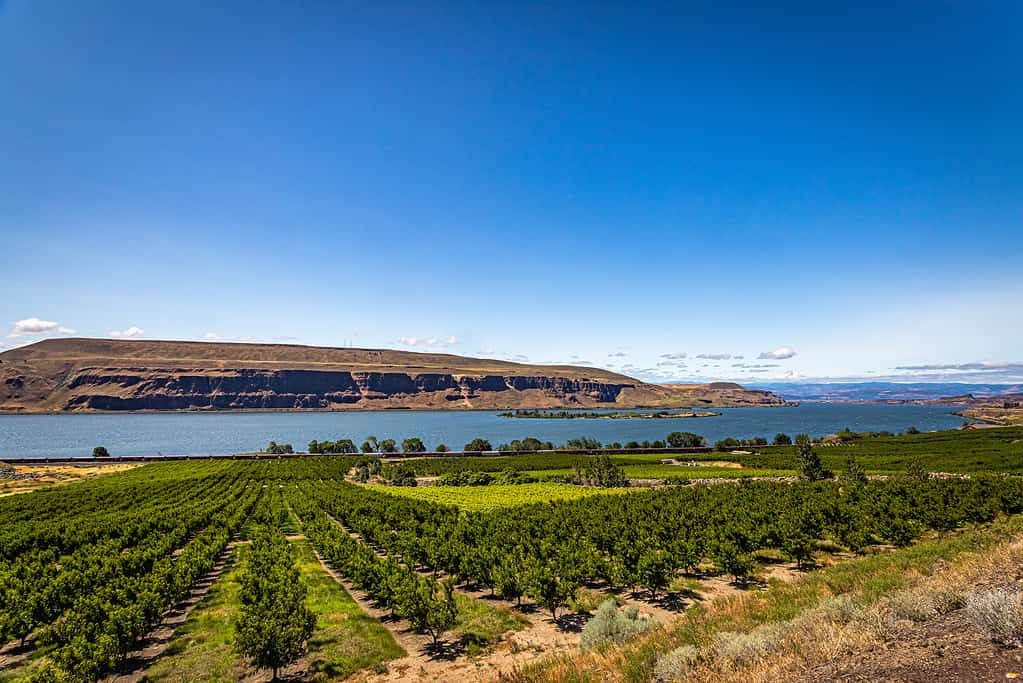
Washington apple orchards grow some of the most sought-after apples in the world.
©Different_Brian/ via Getty Images
Nearly 63% of U.S. apples come from Washington State. These apples grow on over 175,000 acres of orchards in the state. Annual apple production in the state ranges from 5.5 to 6 billion pounds. According to predictions, the 2023 harvest should rebound mightily from the lackluster yields seen in 2021 and 2022. An extreme heat wave hit the state in June 2021. In 2022, snow inhibited pollination after the apple trees bloomed. Both weather episodes drove apple production sharply downward for two consecutive years.
However, the Washington State Tree Fruit Association (WSTFA) expects a nearly 29% increase in apple production in the state in 2023. Jon DeVaney, president of WSTFA, said, “There is a lot of excitement as we are seeing a more normal harvest and excellent fruit quality this year. A moderate spring and a warm early summer created near-perfect growing conditions, so our domestic and foreign customers are going to see great size, color, and overall good quality in our apples.”
Washington’s Orchards
Most of the state’s apples are grown in the eastern foothills of the Cascade Mountains at elevations ranging from 500-3,000 feet above sea level. This region features near-perfect conditions for apple cultivation. The clear mountain water irrigates the orchards. The temperate weather conditions are conducive to apple production. Apples need winter weather in order to set fruit in the spring. As the apples grow, temperature swings from cool nights to warm, sunny days, helping the fruit achieve its maximum potential. The significant differences between nighttime and daytime temperatures allow the fruit to contract and expand. This promotes healthy cell division and creates a crisp, juicy apple at harvest.
Washington produces a wide variety of apples. The state’s top varieties in terms of production numbers include Red Delicious (34%), Gala (19%), Fuji (13%), Granny Smith (12%), Golden Delicious (10%), Cripps Pink (3%), Honeycrisp (3%), Braeburn (3%). The remaining three percent are comprised of other varieties. Ambrosia, Envy, and Cosmic Crisp are all expected to show strong gains among Washington apples in the coming years.
The state is also the largest producer of organic apples in the nation. More than 93% of U.S. organic apples comes from in Washington.
Washington’s Apple Industry
Apples are the top agricultural commodity by production value in Washington, pumping approximately $2.2 billion into the state’s economy each year. Historically, around 30% of Washington apples were exported to approximately 60 different countries. That number is expected to drop to 20% in 2023 due in part to the high tariffs levied by China and India. These two nations were previously large markets for Washington apples. Fifty-two percent of Washington’s fresh apple exports are expected to go to Canada and Mexico. Other top markets for the state’s apples include Vietnam, Taiwan, and Indonesia.
As the top U.S. apple producer, it is fitting that the apple was designated as Washington’s official state fruit in 1989.
2. New York State
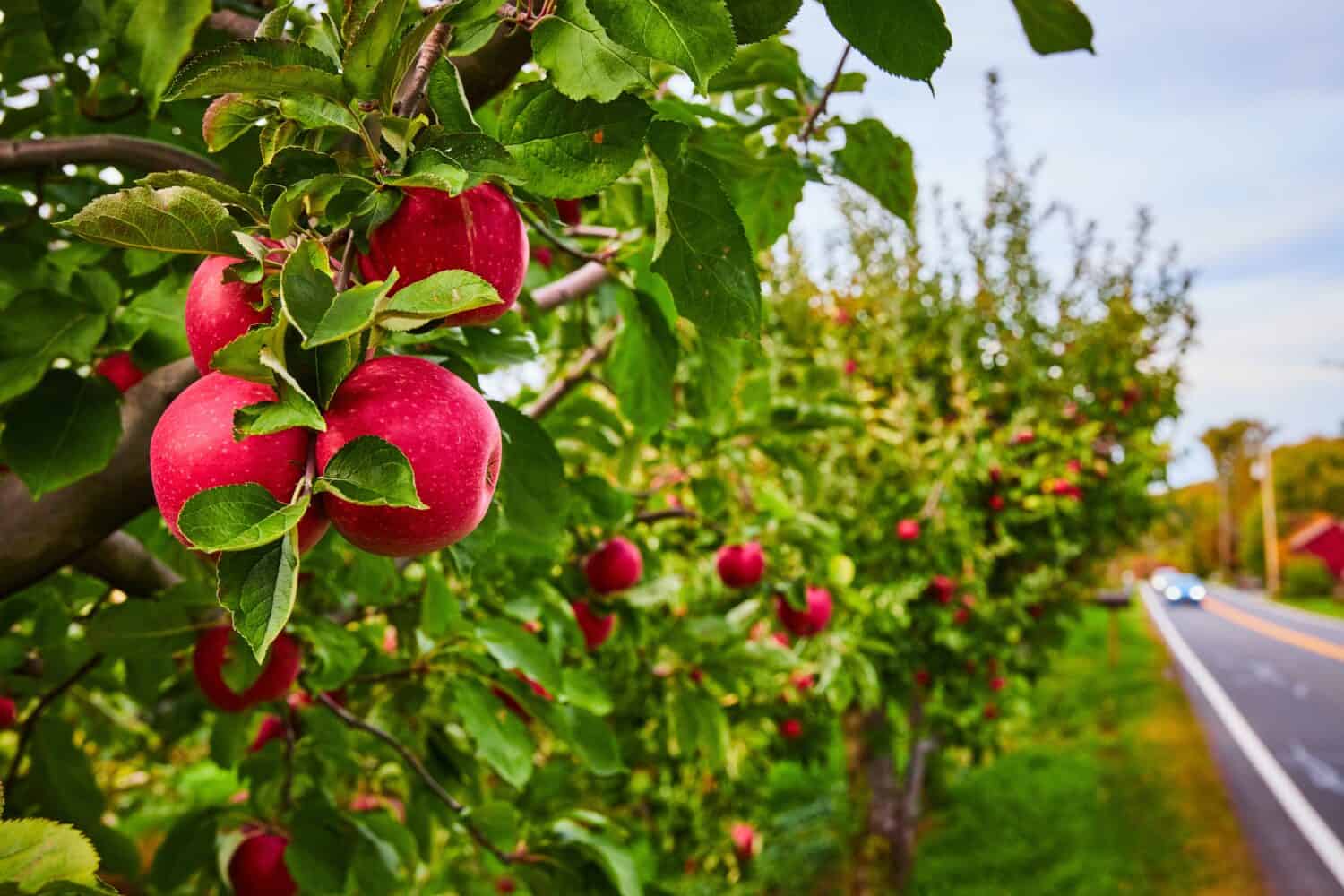
Apple orchards cover 55,000 acres of New York State.
©Nicholas J Klein/Shutterstock.com
New York City is known as the Big Apple, but that moniker could actually be applied to the entire state. New York State boasts the second-highest annual apple production in the U.S. These apples grow on 55,000 acres in the state. Well over 40% of the state’s apple orchard acreage is located in Wayne County. It is the third largest apple-producing county in the nation and the first outside of Washington State. Other top apple-producing counties in New York include Clinton, Columbia, Dutchess, Monroe, Niagara, Onondaga, Orange, Orleans, and Ulster.
The Empire State produces around 1.355 billion pounds of apples each year. New York was the largest apple producer in the nation until Washington surpassed it in the 1940s. Today, while it is still a prime apple-growing state, New York’s production is less than 25% of Washington’s annual yield.
The top New York apple varieties include McIntosh, Empire (fitting for the Empire State!), Red Delicious, Cortland, Golden Delicious, Rome, Idared, Crispin, Paula Red, and Gala.
Like Washington, the nation’s top apple producer, New York has also named the apple as its official state fruit. State legislators gave the fruit this official status in 1976. The apple muffin was also named the official state muffin in 1987.
3. Michigan
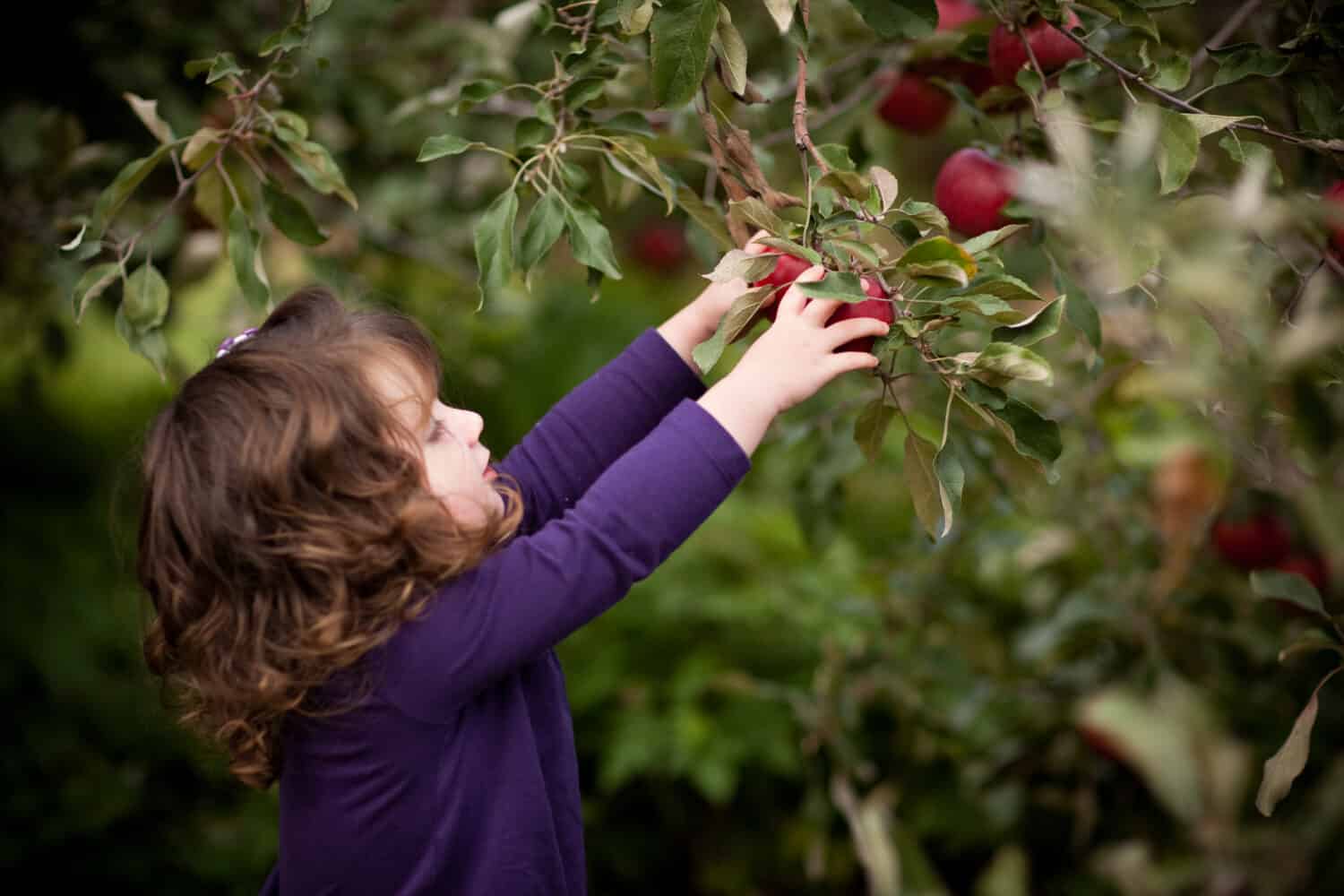
Apple picking is a favorite fall tradition in Michigan.
©Rosemarie Gearhart/Shutterstock.com
Michigan is the third largest apple producer in the U.S., with 14.9 million apple trees covering 34,500 acres of the state. Apples are the largest and most valuable fruit crop in the Great Lakes State and Michigan’s sixth most valuable agricultural commodity overall, behind corn, soybeans, hay, wheat, and potatoes.
Michigan trails closely behind New York in terms of apple production. According to projections, the state’s yield in 2023 should be around 1.344 billion pounds.
Western Michigan boasts more apple trees than any other region in the state. Kent County, where Grand Rapids is located, is the biggest apple-producing county in Michigan, with well over 10,000 acres dedicated to apple cultivation. Apple trees cover around 1.8% of the county.
McIntosh, Jonathon, and Northern Spy have been popular Michigan apple varieties for over a century. Other varieties from Michigan include Braeburn, Cortland, Empire, Gala, Golden Delicious, Ginger Gold, Honeycrisp, Ida Red, Mutsu, Paula Red, and Rome. Approximately 55% of Michigan’s apples are processed into other products, including pies, apple sauce, cider, and juice.
The apple blossom became Michigan’s official state flower in 1897, just sixty years after it became a state. Apples have been central to Michigan’s culture and identity for a very long time.
4. Pennsylvania

Apple orchards proliferate in Adams County, Pennsylvania.
©Open.Tours LLC/Shutterstock.com
The Keystone State is the fourth-largest apple-producing state, but the annual yield is far less than the three top states. Pennsylvania’s orchards yield 400-500 million pounds of apples each year.
You can see apple trees in all 67 of Pennsylvania’s counties, but the largest concentrations grow in Adams, Cumberland, Franklin, and York counties in south-central Pennsylvania. Bedford, Berks, Erie, Juniata, Lehigh, and Snyder counties also house an abundant number of orchards.
Apples are the fourth most valuable crop in Pennsylvania, behind corn, hay, and soybeans.
Red Delicious and Golden Delicious account for around 46% of the state’s apple production. Other popular varieties grown in Pennsylvania include Cripps Pink (also known as Pink Lady), Fuji, Gala, McIntosh, and Jonagold.
5. California
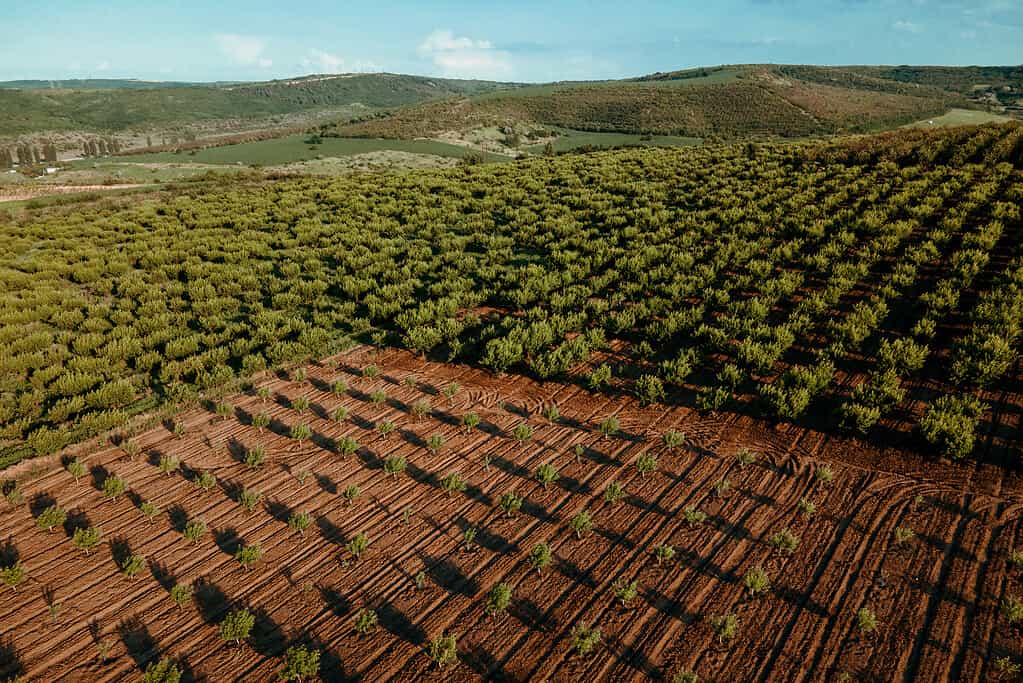
California is not only home to the headquarters for Apple, Inc. It is also home to 14,000 acres of apple orchards!
©Alexandr Muşuc/ via Getty Images
California is much more well-known for its vineyards than its apple orchards, but the state houses some 14,000 acres of land dedicated to apple cultivation. Apple farming is worth around $105 million to the California economy each year.
Due to its unique climate, California typically provides some of the first fresh apples of the season, often beating Washington by three weeks. That small window is very valuable to California growers. After Washington’s apple harvest, the price of their product drops.
The top five California counties for apple production include El Dorado, San Joaquin, Santa Cruz, Sonoma, and San Bernardino. The major apple varieties grown in the Golden State include Cripps Pink, Fuji, Gala, and Granny Smith.
6. Virginia
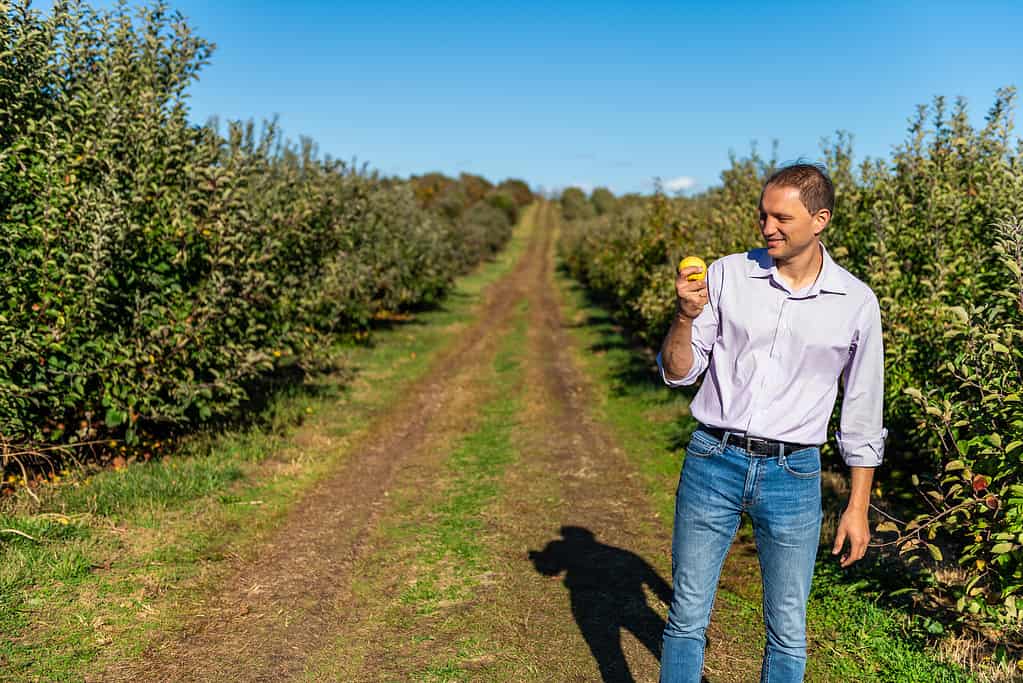
Farmers in Virginia grow the sixth-most apples among all U.S. states.
©krblokhin/ via Getty Images
Virginia sits on the southern edge of the U.S. apple-growing region. There are more than 100 commercial orchards in the Old Dominion situated on over 16,000 acres of land, most of which are located in the Shenandoah Valley.
Virginia’s annual apple yield is around 184.5 million pounds. Some popular varieties of Virginia apples include Gala, Ginger Gold, Golden Delicious, Granny Smith, Jonathan, Red Delicious, Rome, Stayman, Winesap, and York.
7. Oregon

The winesap is a tart, small apple grown in Oregon.
©Danita Delimont/Shutterstock.com
There are around 6,800 acres of apple orchards in Oregon. While you can see apple trees throughout the state, the majority of Oregon’s orchards are in three regions: the Willamette Valley, the Mid-Columbia Valley, and the Milton-Freewater area.
The Beaver State’s annual apple yield is around 140-175 million pounds. The top varieties of Oregon apples include Braeburn, Gala, Granny Smith, Honeycrisp, Jonagold, and Winesap.
8. North Carolina
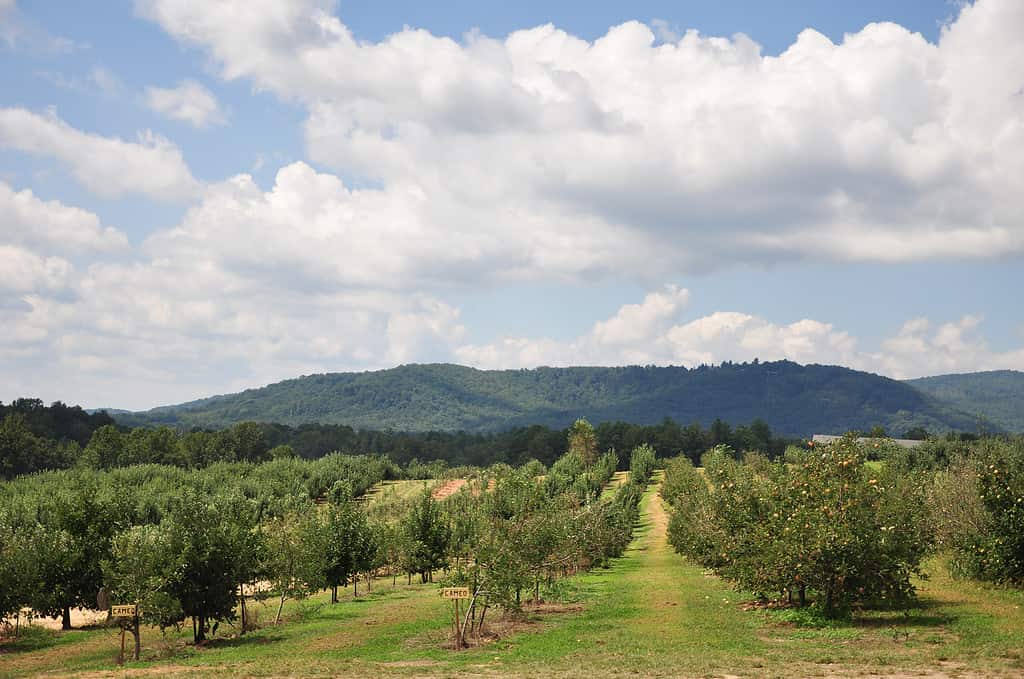
North Carolina orchards produce about 150 million pounds of apples per year.
©ejkrouse/ via Getty Images
Apples have a long history in North Carolina, dating back to the eighteenth century. Around 150 million pounds of apples are harvested in the Tar Heel State each year.
Henderson County in southwest North Carolina accounts for around 80% of the state’s total apple production. The top apple varieties grown in North Carolina include Golden Delicious, Red Delicious, Rome, and Stayman.
9. Ohio

Fall is apple time in Ohio!
©Trevor Gessay/ via Getty Images
Ohio is famous for many things, but apples may not be near the top of the list. However, the Buckeye State is the ninth-largest producer of apples in the nation. Apples are grown throughout the state.
While over 50 varieties of apples are grown in Ohio, only one is recognized as the official state apple. The Melrose apple was developed by Freeman S. Howlett at the Ohio Agricultural Experiment Station and was introduced in 1944.
10. Idaho

Northern Spy apples are an heirloom variety grown in Idaho.
©geoBee/Shutterstock.com
Idaho is famous for its potatoes, but apples? Not as much. The Gem State is the tenth-largest apple producer in the nation, though.
Apples in Idaho date back to the 1890s. Apple orchards are typically found in a relatively small part of the state. Most orchards are located in the southwest region of Idaho near Boise. The valley between the Snake and Payette rivers is ideally suited for apple cultivation.
Apple Harvest
Apples are typically harvested in the fall, with September and October being the prime months. Different varieties can be harvested as early as July in some locations, though.
It is a labor-intensive process. Machines cannot harvest apples because the fruit is easily bruised. Instead, apples are picked by hand.
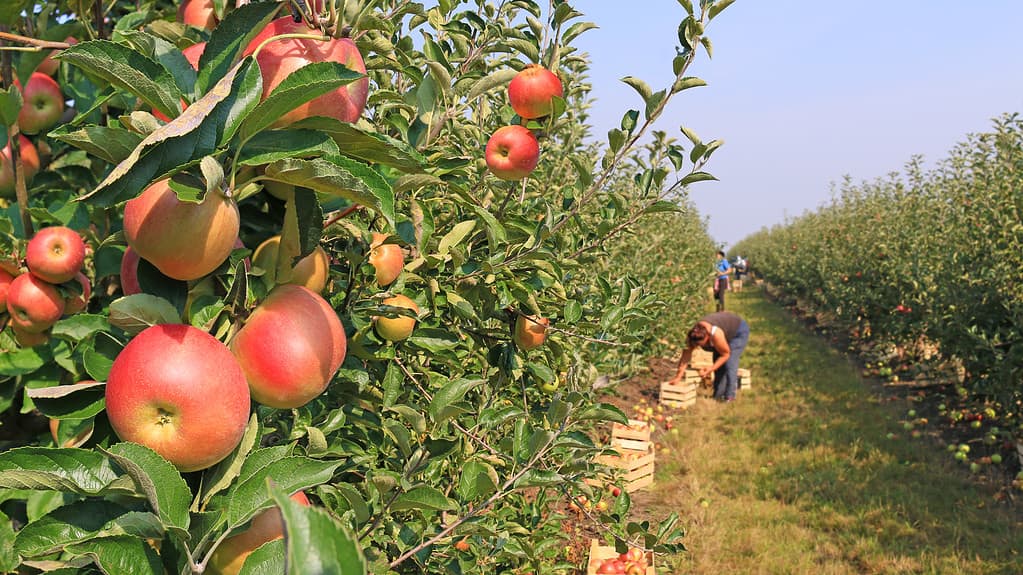
Apples must be harvested by hand.
©branex/ via Getty Images
Controlled Atmosphere Storage enables the year-round availability of fresh apples, despite the fall harvest season. By placing apples in airtight, climate-controlled warehouses, and meticulously monitoring the low-oxygen environment, we significantly slow down their ripening process. This practice ensures a constant supply of fresh apples all year long.
Health Benefits of Apples
You’ve heard the old axiom, “An apple a day keeps the doctor away.” While that may be a bit of an overstatement, there is no denying that apples are a wonderfully healthy fruit.
Apples are free of fat, cholesterol, and sodium. They are rich in antioxidants and phytonutrients. The fruit is also very high in vitamin C.
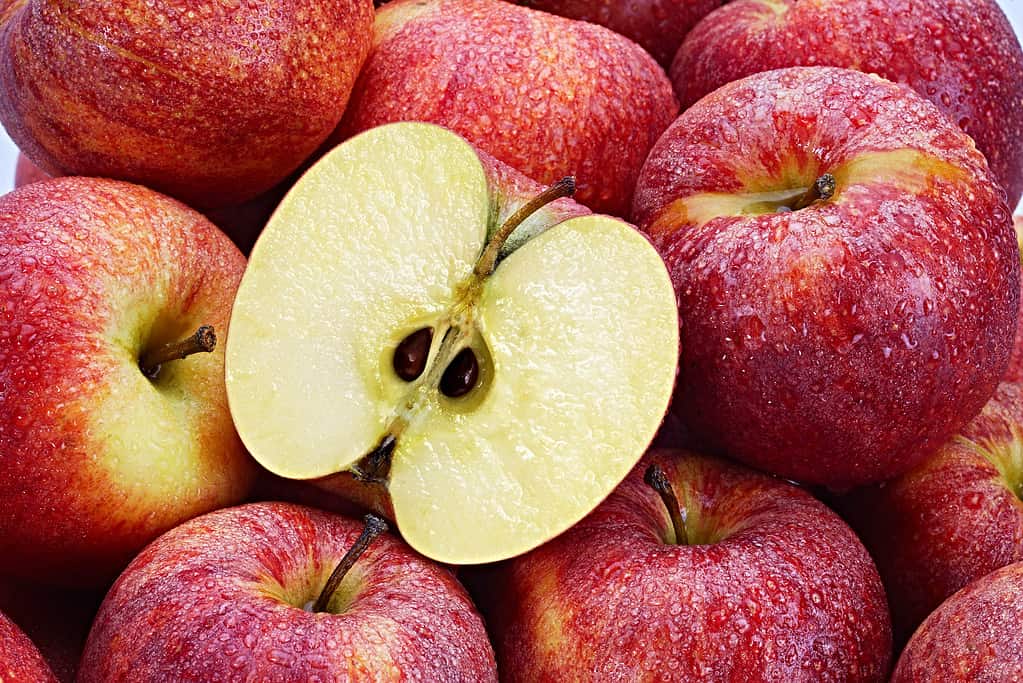
Apples are a super healthy fruit.
©hacohob/Shutterstock.com
Apples have triterpenoids that can suppress inflammation, probiotic fiber that feeds the good bacteria in the gut, and other properties that may reduce cardiovascular disease.
To reap the most health benefits from an apple, be sure to eat the peel, where you can find most of the vitamins and fiber.
Fun Apple Facts
The United States is the second biggest producer of apples in the world. China grows the vast majority of the world’s apples, producing over 101 billion pounds annually. That is nearly 50% of the world’s annual apple production each year. However, most of the apples Americans consume come from the United States. The U.S. only imports about five percent of its total apple supply.
Apples are the second biggest fruit crop grown in the United States today, trailing only grapes. The remaining top ten U.S.-grown fruits include oranges, strawberries, tangerines and mandarins, lemons, pears, peaches, grapefruit, and cranberries.
Non-Native Apples
Apples are thought to have originated between the Caspian and Black Seas. The fruit was a favorite of the ancient Greeks and Romans.
The crabapple is the only apple native to North America. Those sour apples were not exactly appetizing for new settlers. Sweet apples were introduced by colonists in the seventeenth century. Reverend William Blaxton is said to be the first person to plant an apple orchard on the continent. He planted the orchard in New England in 1625.
John Chapman, better known as Johnny Appleseed, brought apple trees to large regions of Pennsylvania, Ohio, Indiana, and several other states.

Johnny Appleseed was born in Massachusetts in 1774.
©Daderot / Public domain – License
Americans Love Their Apples
There are around 7,500 varieties of apples worldwide. They range in size from a little larger than a cherry to the size of a grapefruit.
The average American eats 16 pounds of apples per year. The Gala is the most popular apple in the United States today. Nearly 20% of apples grown in the U.S. are Galas. The remainder of the top five apple varieties in the U.S. include Red Delicious, Honeycrisp, Fuji, and Granny Smith.
Apple Science
Pomology is the name of the science of growing apples.
The energy of 50 apple tree leaves is required to produce one apple. Depending on the variety, an apple tree can produce fruit for 20–100 yeras.
Apple blossoms must be cross-pollinated by bees or other pollinators, or they will not turn into fruit.
The average apple contains 5 seeds. Calyx is the name of the star-shaped bottom of an apple.
Refrigeration greatly extends the life of an apple. The fruit ripens ten times slower when refrigerated than when left at room temperature.
If you have ever bobbed for apples, you know that apples float. The reason the fruit floats is because it is 85% water.

Apple trees cannot produce fruit without pollinators.
©Byrdyak/iStock via Getty Images
The photo featured at the top of this post is © Philip Stewart/iStock via Getty Images
Thank you for reading! Have some feedback for us? Contact the AZ Animals editorial team.







